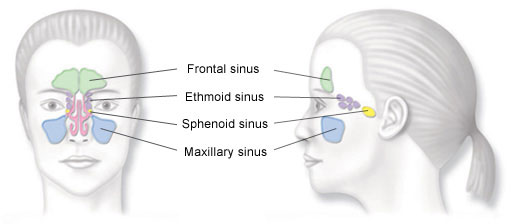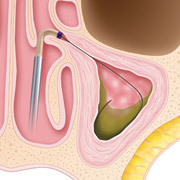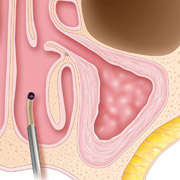Balloon Sinuplasty (BSP) uses a small, flexible, balloon catheter to open up blocked sinus passageways and facilitate drainage of the mucus that builds up in patients suffering from chronic sinusitis. When the sinus balloon is inflated, it restructures and widens the walls of the sinus passageway while maintaining the integrity of the sinus lining.
Unlike traditional sinus surgery, Balloon Sinuplasty requires no cutting and no removal of bone and tissue. Published clinical data in the leading ENT journal shows that it is safe and effective: patients experienced no adverse events and received statistically and clinically significant improvement in their sinusitis symptoms.
The following illustrations show how Balloon Sinuplasty opens a blocked left maxillary sinus:
Step 1. A balloon catheter is inserted into the inflamed sinus.
Step 2. The balloon is inflated to expand the sinus opening.
Step 3. Saline is sprayed into the inflamed sinus to flush out the pus and mucus.
Step 4. The system is removed, leaving the sinuses open.
Balloon Sinuplasty is typically performed under general anesthesia in an outpatient setting. It is now also available to some patients as a procedure conducted in a doctor’s office under local anesthesia.
Clinical data shows that Balloon Sinuplasty provides symptom relief:
- 95% of patients demonstrated that sinus symptoms improved in an average follow-up period of 9 months in a multi-center study of 1,036 patients who had Balloon Sinuplasty
- Another multi-center study followed 65 patients who had Balloon Sinuplasty and reported clinically and statistically significant improvement in patient symptoms out to two years.
- 95% percent of patients who had Balloon Sinuplasty would recommend the procedure to their family and friends.





